In 2025, wage disparities across Europe highlight significant challenges to economic stability and living standards. While several countries have implemented notable minimum wage increases to counter inflation, others have made only modest adjustments. This divergence underscores the continent’s ongoing struggle with income inequality and rising living costs.
To better understand these trends, the team at BestBrokers analysed changes in minimum monthly salaries across European countries between 2024 and 2025, alongside average hourly wages in select capitals. The findings reveal that some governments have actively pursued wage growth to improve living standards, while others remain constrained by economic or policy factors. These contrasts reflect fundamental differences in productivity, cost of living, and labour market structures across Europe.
In countries such as the UK, Luxembourg, and Ireland, full-time minimum wage workers now earn over €2,100 per month, whereas in Serbia, Bulgaria, and Armenia, monthly minimum wages remain below €620. By mapping these income shifts, this report highlights where Europe’s workers are making progress and where challenges persist. The findings offer valuable insights into broader trends in economic development, social policy, and inequality across the continent.
Key takeaways:
- Bosnia and Herzegovina recorded the largest minimum wage increase in Europe for 2025, a 64.69% jump from the previous year, while Armenia and Cyprus made no adjustments at all, despite rising living costs.
- Luxembourg remains the European leader in minimum monthly income with a 2025 guaranteed wage of at least €2,638, while Armenia ranks last at just €183, revealing a more than 30-fold gap between the continent’s highest and lowest earners.
- In terms of capitals, the highest average hourly wages are found in Bern (€40.01), Luxembourg (€38.43), and Copenhagen (€30.65), reflecting the strength and stability of their respective economies.
- Workers in Zagreb earn just €1.41 per hour, which is the lowest average hourly wage in Europe. It is closely followed by Armenia with €2.90, and Bosnia and Herzegovina with €4.90.
- Despite implementing only a modest 2.61% increase in its minimum wage for 2025, Luxembourg retains its position among Europe’s highest-paying countries, unlike Bosnia and Herzegovina, which, despite the better increase, still cannot make it into the top 5.
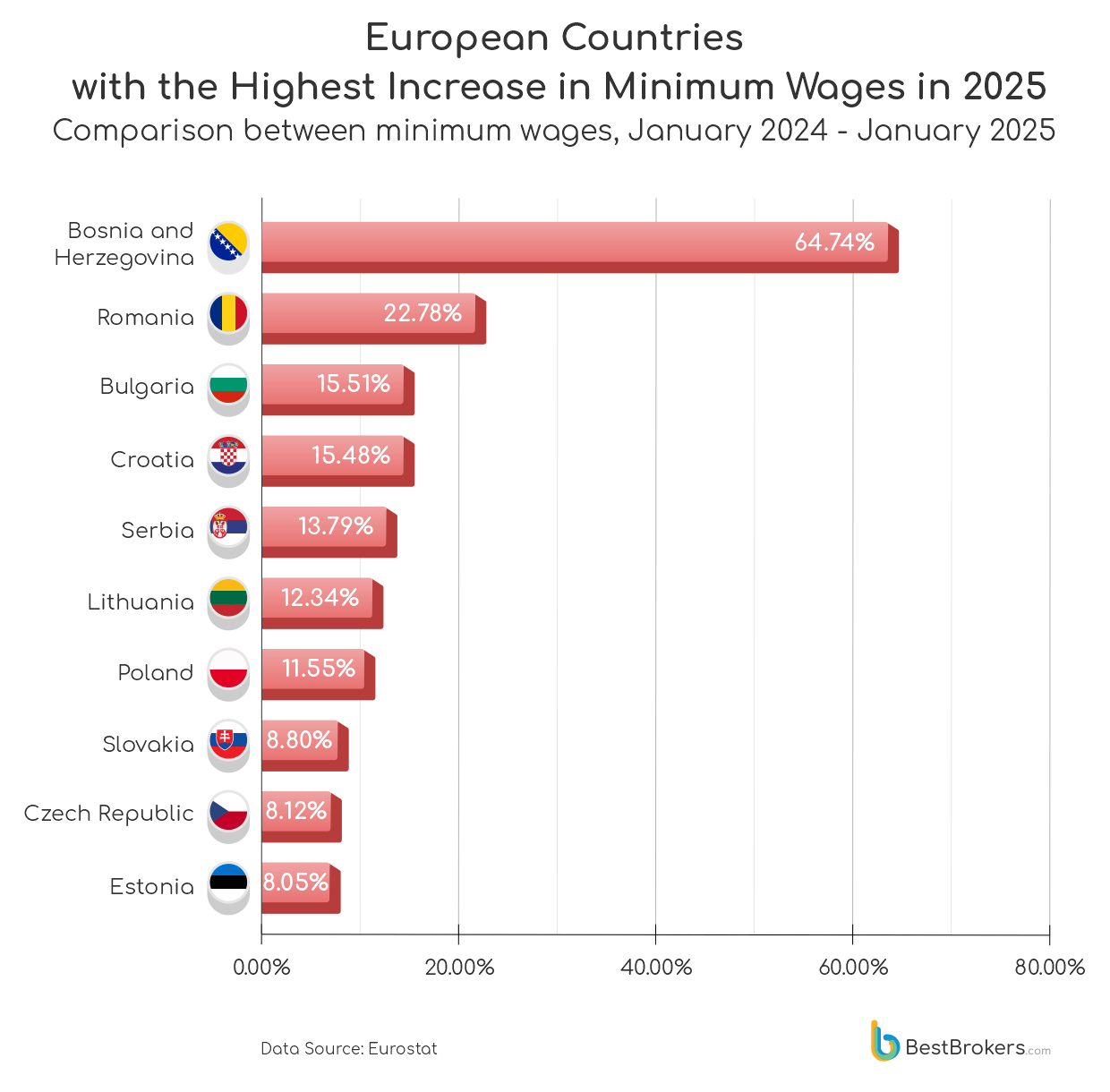
Countries With the Highest Increase in Minimum Wage for 2025
Wage levels vary greatly across Europe, but the pace of pay increase reveals much about each country’s economic outlook. Over the past year, several countries have made substantial adjustments to their minimum wages, reflecting inflation responses, labour market reforms, and efforts to align with EU standards.
Leading the continent, Bosnia and Herzegovina raised its minimum wage by a staggering 64.69%, more than doubling the national base income and signalling a major policy shift. Romania ranks second with an increase that is less significant but still impressive, 22.78%, while Bulgaria and Croatia implemented nearly identical increases of 15.51% and 15.48%, respectively.
Serbia rounds out the top five with an increase of 13.79%. These year-over-year changes not only aim to improve living standards, but also reflect each country’s broader economic and political commitments to wage growth and income equality.
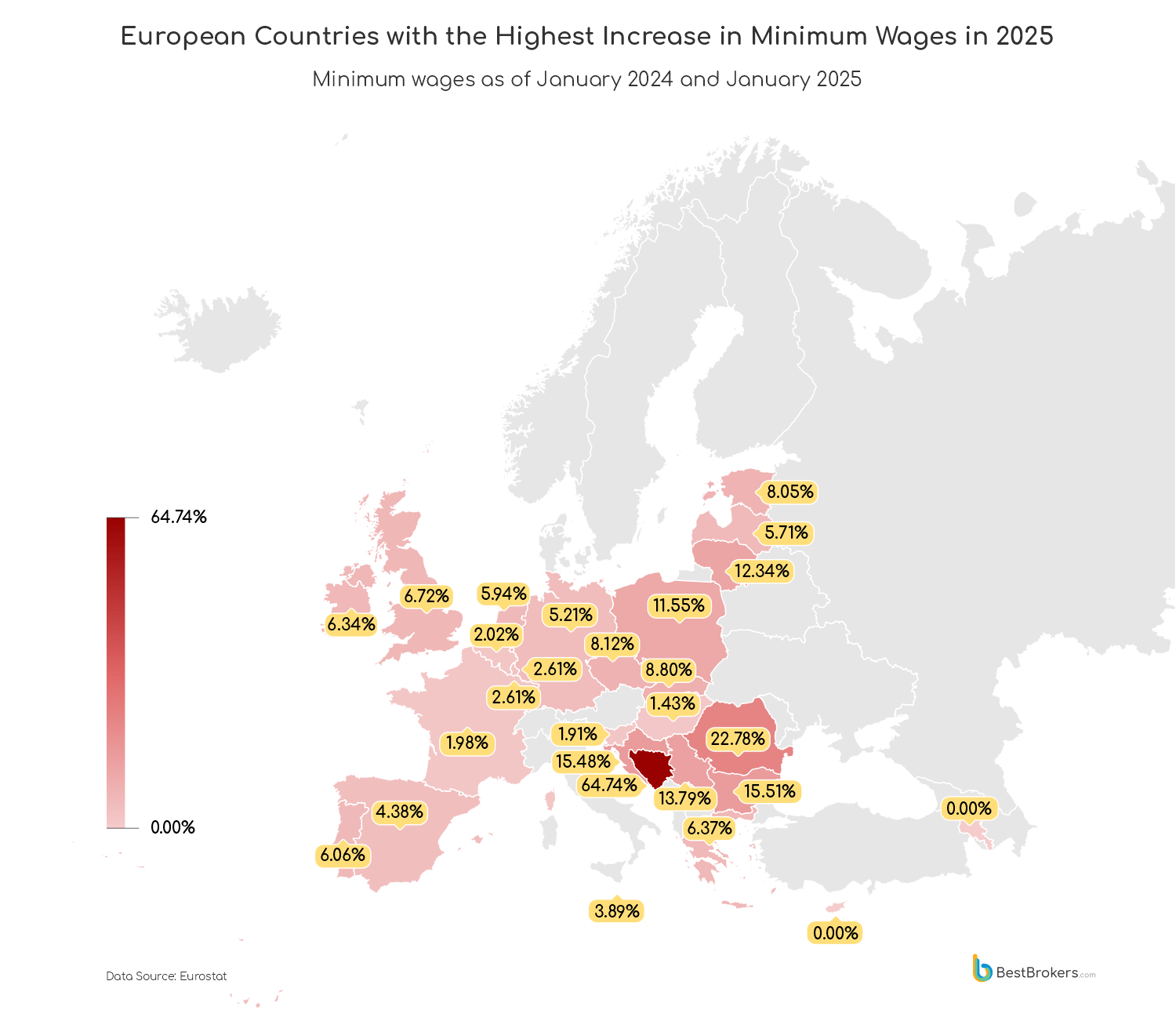
Countries With the Lowest Increase in Minimum Wage for 2025
At the other end of the spectrum, several European countries have made little to no adjustments to their minimum wage levels over the past year. Armenia and Cyprus stand out as exceptions, being the only two nations with no increase at all between 2024 and 2025, maintaining their existing minimum wage levels despite rising living costs.
It is important to mention that although Armenia is situated in Asia, it identifies culturally and politically with Europe and is widely regarded as falling within the European geopolitical sphere. Armenia’s parliament has formally passed legislation initiating the country’s bid to join the European Union, representing a significant step on its path toward possible EU membership.
Among the countries that did implement increases are, Hungary at 1.43%, followed by Slovenia at 1.91%, and France and Belgium with modest increases of 1.98% and 2.02%, respectively. Even Luxembourg, which has the highest minimum wages in Europe, saw only a 2.61% increase, a comparatively restrained adjustment.
These limited changes may reflect low inflation rates, economic caution, or reliance on broader welfare systems, but they also raise questions about whether minimum wage policies are keeping pace with everyday costs in some of Europe’s wealthiest and most stable economies.
Highest Minimum Wages in Europe
When it comes to absolute income levels, the highest minimum wages in Europe are consistently found in a small group of economically strong countries. The top five remain unchanged between 2024 and 2025: Luxembourg, the United Kingdom, Ireland, the Netherlands, and Germany.
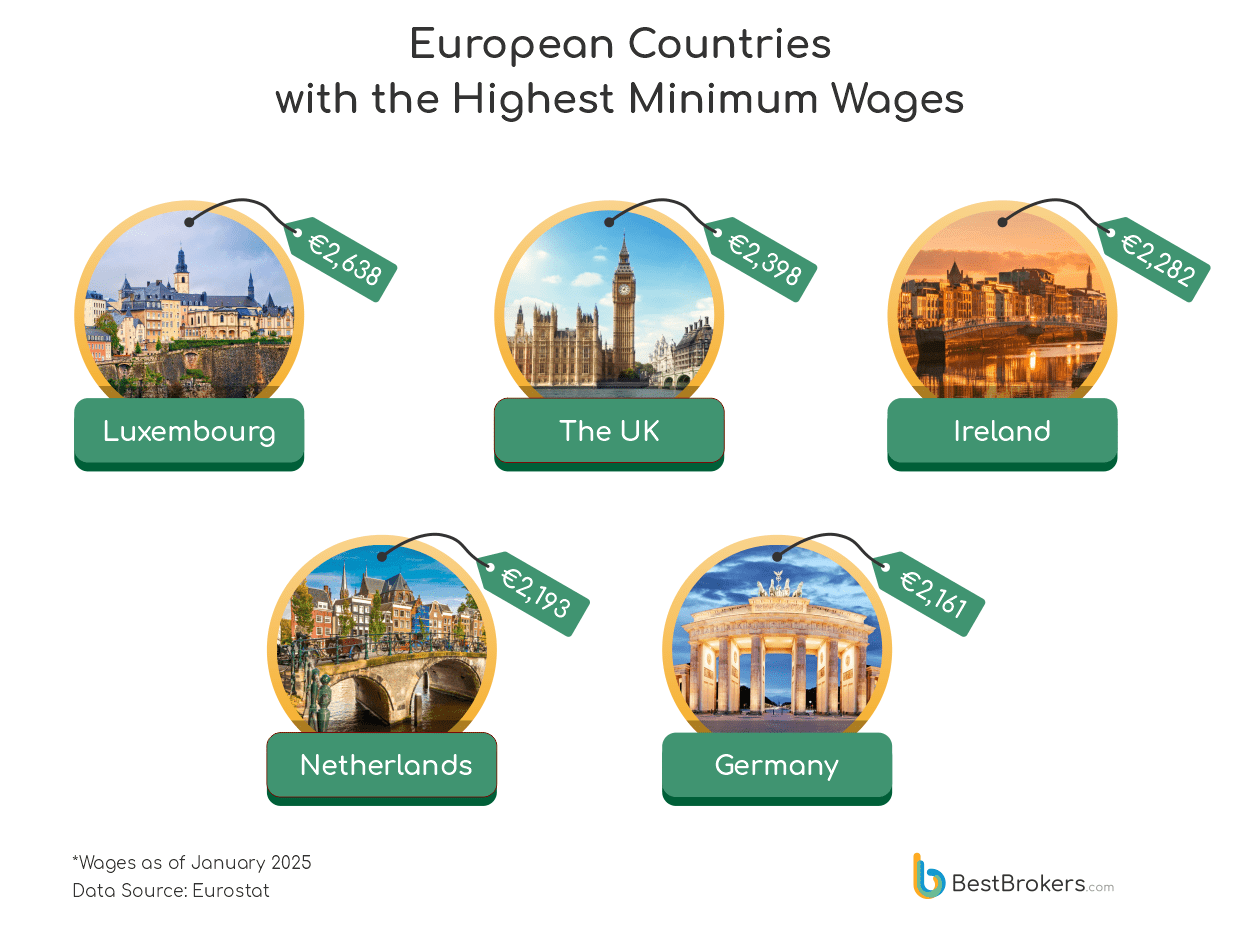
Luxembourg’s minimum wage reached €2,505 in 2025, the highest among countries with legislated national minimum wages in Europe. This was a slight increase of 2.61% from 2024. In the United Kingdom, it went from €2,247 to €2,398, and in Ireland, from €2,146 to €2,282.
These figures illustrate the sustained commitment of these countries to maintain high wage floors, offering a stark contrast to lower-income economies elsewhere on the continent.
Lowest Minimum Wages in Europe
While some European nations offer strong minimum wage protections, others lag significantly behind, shedding light on the deep economic disparities across the continent.
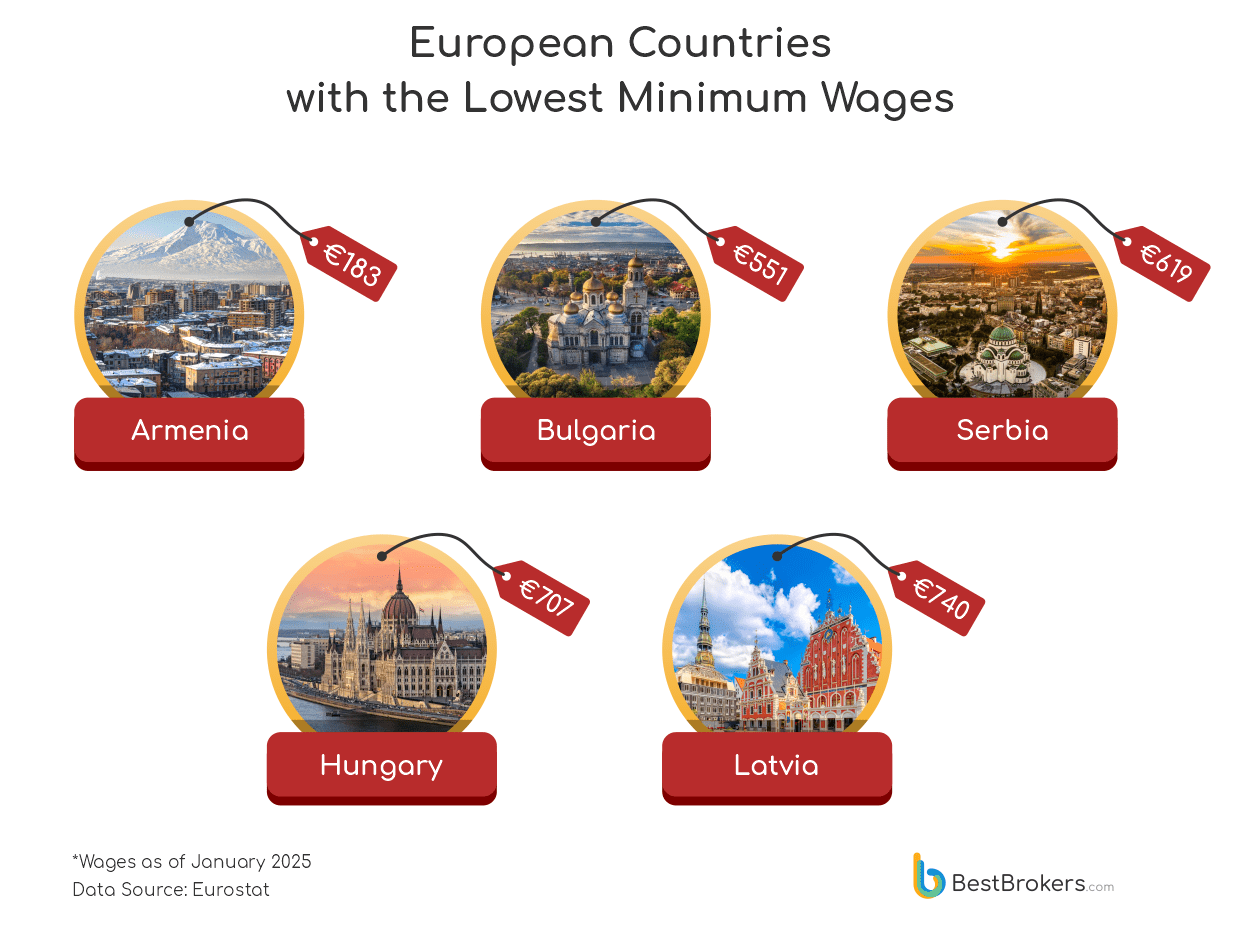
In both 2024 and 2025, Armenia records the lowest position concerning minimum wage, fixed at €183, with no increase at all over the year.
The next lowest minimum wages in 2025 can be found in Bulgaria at €551, Serbia at €619, Hungary at €707, and Latvia at €740.
There is a slight shift from 2024, when the ranking also included Bosnia and Herzegovina (€485) and Romania (€663), but their substantial increases in 2025 pushed them out of the bottom five.
This highlights a noticeable income gap between Eastern and Western Europe, pointing to the challenge many countries face in aligning wage growth with the rising living costs and EU benchmarks.
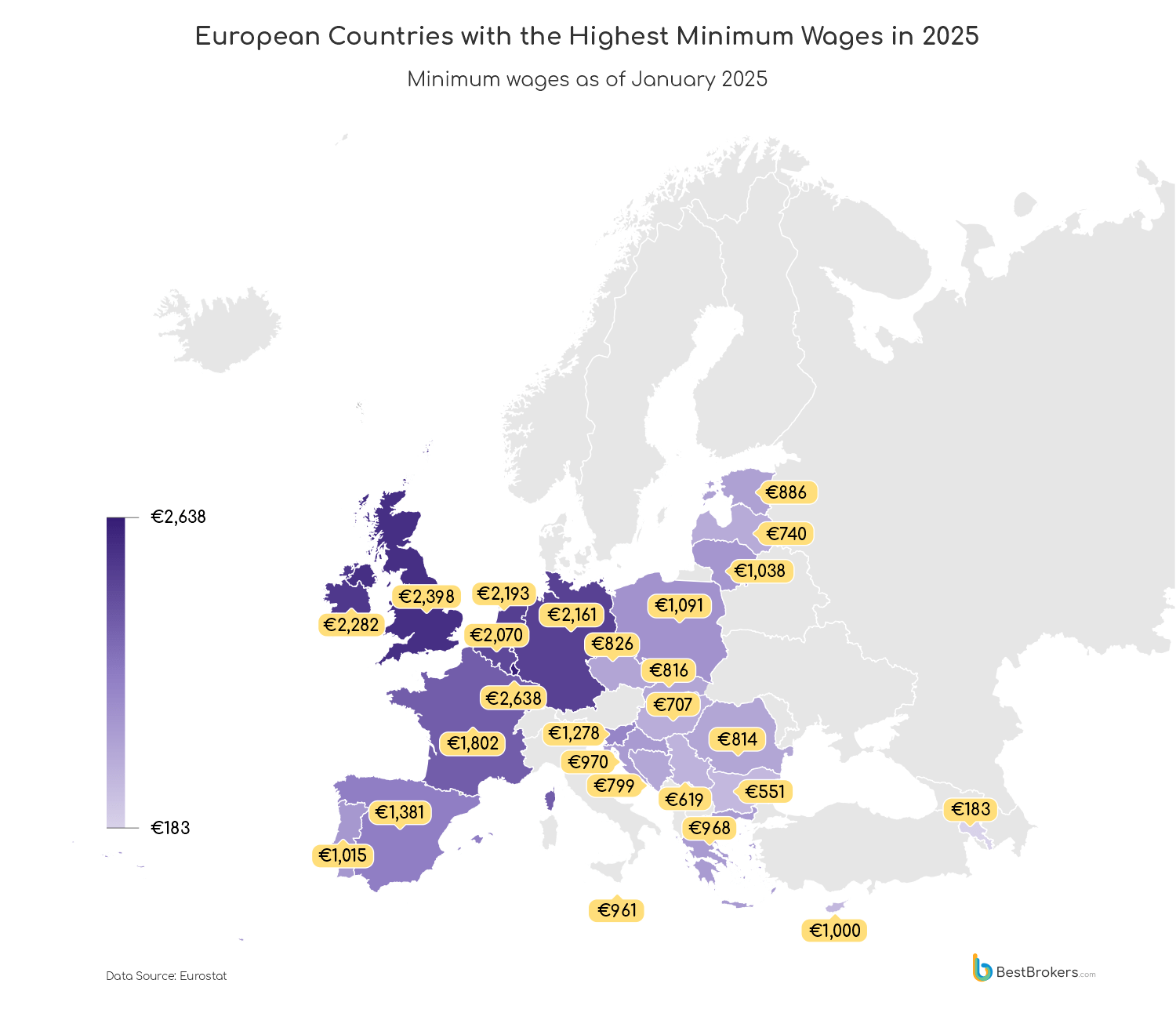
Capitals with the Highest Hourly Wage Rate
Beyond national minimum wages, average hourly earnings in European capitals provide deeper insight into labour market strength and overall economic prosperity.
According to data from SalaryExpert, leading the rankings here is Bern, Switzerland, where the average hourly wage reaches an impressive €40.01, reflecting the country’s high standards of living. Close behind is Luxembourg, where workers earn an average of €38.43 per hour, making it one of the most lucrative capitals within the European Union.
In Copenhagen, Denmark, strong labour protections and collective bargaining contribute to similarly elevated wage levels at €30.65 per hour. Berlin and Amsterdam round out the top five, each offering average hourly earnings of around €27.
These cities not only represent the wealthiest parts of Europe, but also exemplify how wage levels can reflect broader economic competitiveness, cost of living, and workforce specialisation.
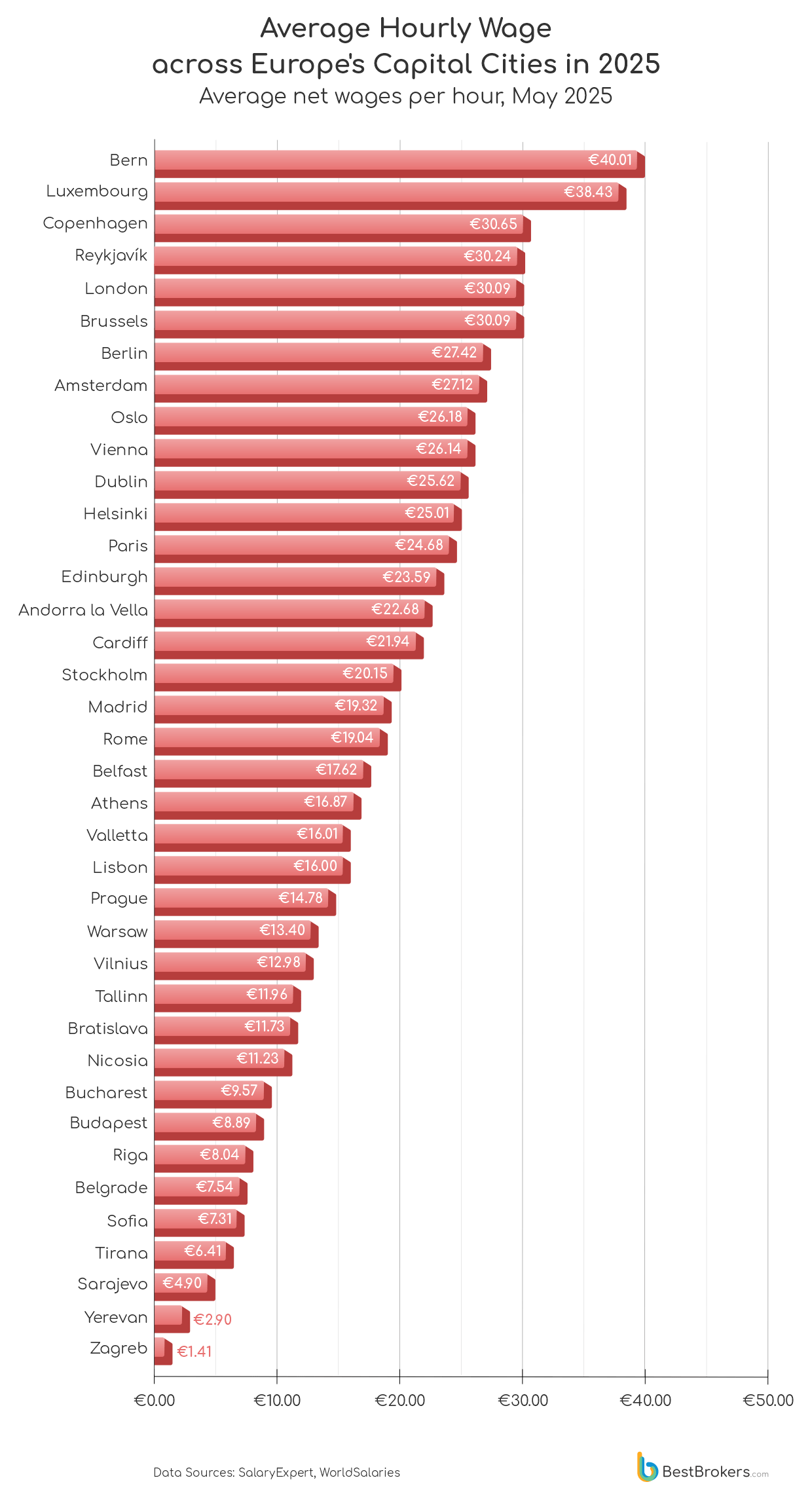
Capitals in Southeast and Eastern Europe report the lowest average hourly wages on the continent. Zagreb, Croatia, ranks last, with workers earning just €1.41 per hour on average, highlighting significant labour market challenges. Yerevan, Armenia, follows with €2.90 per hour, while Sarajevo, Bosnia and Herzegovina, averages €4.90 per hour despite recent minimum wage reforms. In Tirana, Albania, workers earn approximately €6.41 per hour, and in Sofia, Bulgaria, the figure stands at €7.31.
Those low earnings reveal the stark contrast with wealthier Western capitals and reflect the persistent wage convergence struggles facing parts of the Balkans and the Caucasus. While some annual improvements have been made, the gap in average income levels remains substantial across Europe, with real consequences for affordability, labour mobility, and living standards.
Methodology
This report analyses changes in minimum and average wages across Europe to highlight income disparities and growth trends between 2024 and 2025. Minimum monthly wage data for both years was sourced from official and publicly available outlets, including Eurostat, gov.uk, Europa.jobs, and national government agencies. Year-over-year percentage increases were calculated using standard comparison methods.
To complement this, average hourly wage data for 2025 was collected for major European capitals from platforms such as SalaryExpert, WorldSalaries, and Glassdoor. These figures helped identify the cities with the highest and lowest average hourly earnings.
By comparing both minimum and average wages, the report provides insights into income levels, labour market dynamics, and regional disparities across Europe.
